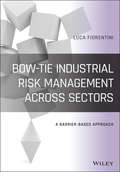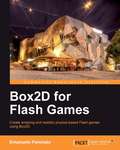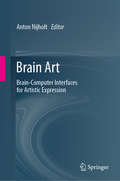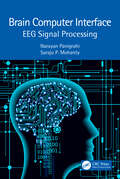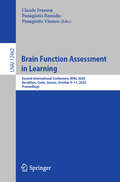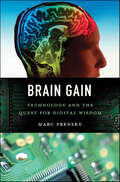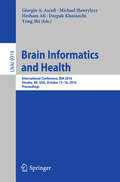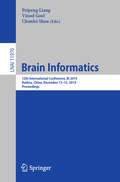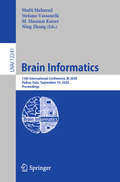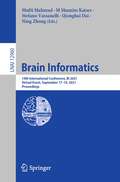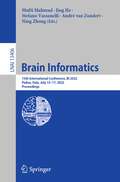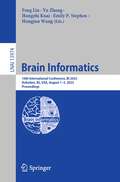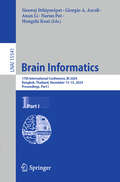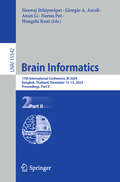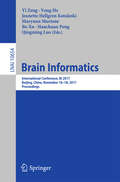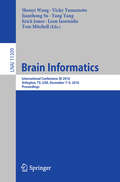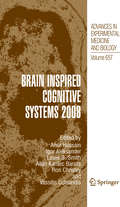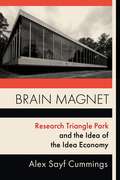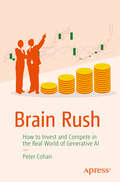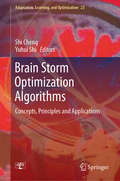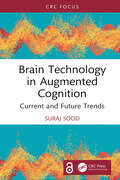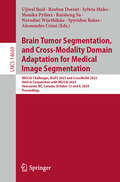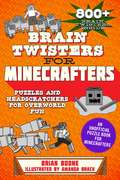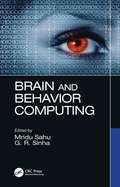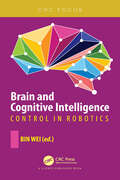- Table View
- List View
Bow-Tie Industrial Risk Management Across Sectors: A Barrier-Based Approach
by Luca FiorentiniBOW-TIE INDUSTRIAL RISK MANAGEMENT ACROSS SECTORS Explore an approachable but rigorous treatment of systematic barrier-based approaches to risk management and failure analysisIn Bow-Tie Industrial Risk Management Across Sectors: A Barrier-Based Approach, accomplished researcher and author Luca Fiorentini delivers a practical guide to risk management tools, with a particular emphasis on a systematic barrier-based approach called “bow-tie.” The book includes discussions of two barrier-based methods, Bow-Tie and Layers of Protection Analysis (LOPA), for risk assessment, and one barrier-based method for incident analysis, Barrier Failure Analysis (BFA). The author also describes a traditional method–Root Cause Analysis–and three quantitative methods–FMEA/FMECA, Fault Tree (FTA), and Event Tree (ETA) with a discussion about their link with barriers.Written from the ground up to be in full compliance with recent ISO 31000 standards on enterprise risk management, and containing several case studies and examples from a variety of industries, Bow-Tie Industrial Risk Management Across Sectors also contains discussions of international standards dealing with common risks faced by organizations, including occupational health and safety, industrial safety, functional safety, environmental, quality, business continuity, asset integrity, and information security.Readers will also benefit from the inclusion of:A thorough introduction to the Bow-Tie method, including its practical application in risk management workflow from ISO 31000, the history of Bow-Tie, related methods, and the application of Bow-Tie in qualitative and quantitative waysAn exploration of Barrier Failure Analysis, including events, timelines, barriers, causation paths, and multi-level causesA practical discussion of how to build a Barrier Failure Analysis, including fact finding, event chaining, identifying barriers, assessing barrier states, causation analysis, and recommendationsA concise treatment of Bow-Tie construction workflow, including a step-by-step guidePerfect for engineers and other professionals working in risk management, Bow-Tie Industrial Risk Management Across Sectors: A Barrier-Based Approach will also earn a place in the libraries of advanced undergraduate and graduate students studying risk management and seeking a one-stop reference on the “bow-tie” approach and barrier-based methods.
Box2D for Flash Games
by Emanuele FeronatoThis book is a step by step guide to create games with Box2D explained in a simple and friendly way. Are you familiar with ActionScript3 and want to explore the capabilities of physics in game design using Box2D, then this book is for you. You don't have to be an AS3 hero: if you know how to create classes and functions with AS3, then you can make your first physics game!
Brain Art: Brain-Computer Interfaces for Artistic Expression
by Anton NijholtThis is the first book on brain-computer interfaces (BCI) that aims to explain how these BCI interfaces can be used for artistic goals. Devices that measure changes in brain activity in various regions of our brain are available and they make it possible to investigate how brain activity is related to experiencing and creating art. Brain activity can also be monitored in order to find out about the affective state of a performer or bystander and use this knowledge to create or adapt an interactive multi-sensorial (audio, visual, tactile) piece of art. Making use of the measured affective state is just one of the possible ways to use BCI for artistic expression. We can also stimulate brain activity. It can be evoked externally by exposing our brain to external events, whether they are visual, auditory, or tactile. Knowing about the stimuli and the effect on the brain makes it possible to translate such external stimuli to decisions and commands that help to design, implement, or adapt an artistic performance, or interactive installation. Stimulating brain activity can also be done internally. Brain activity can be voluntarily manipulated and changes can be translated into computer commands to realize an artistic vision. The chapters in this book have been written by researchers in human-computer interaction, brain-computer interaction, neuroscience, psychology and social sciences, often in cooperation with artists using BCI in their work. It is the perfect book for those seeking to learn about brain-computer interfaces used for artistic applications.
Brain Computer Interface: EEG Signal Processing
by Saraju P. Mohanty Narayan PanigrahiBrain Computer Interface: EEG Signal Processing discusses electroencephalogram (EEG) signal processing using effective methodology and algorithms. This book provides a basic introduction to EEG and a classification of different components present in EEG. It also helps the reader to understand the scope of processing EEG signals and their associated applications. Further, it covers specific aspects such as epilepsy detection; exploitation of P300 for various applications; design of an EEG acquisition system; and detection of saccade, fix, and blink from EEG and EOG data. Key Features: Explains the basis of brain computer interface and how it can be established using different EEG signal characteristics Covers the detailed classification of different types of EEG signals with respect to their physical characteristics Explains detection and diagnosis of epileptic seizures from the EEG data of a subject Reviews the design and development of a low-cost and robust EEG acquisition system Provides mathematical analysis of EEGs, including MATLAB® codes for students to experiment with EEG data This book is aimed at graduate students and researchers in biomedical, electrical, electronics, communication engineering, healthcare, and cyber physical systems.
Brain Function Assessment in Learning: Second International Conference, BFAL 2020, Heraklion, Crete, Greece, October 9–11, 2020, Proceedings (Lecture Notes in Computer Science #12462)
by Claude Frasson Panagiotis Bamidis Panagiotis VlamosThis book constitutes the thoroughly refereed proceedings of the Second International Conference on Brain Function Assessment in Learning, BFAL 2020, held in Heraklion, Crete, Greece, in October 2020*.The 11 revised full papers and 10 short papers presented were carefully selected from 35 submissions. The BFAL conference aims to regroup research in multidisciplinary domains such as neuroscience, computer science, medicine, education, human-computer interactions, and social interaction on the theme of Brain Function Assessment in Learning.*The conference was held virtually due to the COVID-19 pandemic.
Brain Gain: Technology and the Quest for Digital Wisdom
by Marc Prensky"In an age where the answer to every question is at your fingertips, where does the human brain fit in?"In one hand-held object, we are able to manage all of our calendars, documents, and interpersonal relationships with such ease that many people are lost when forced to do perform these tasks without the aid of electronics. Often heard are the calls for less technology and more face-to-face interaction, for fear that the use of all this artificial intelligence is dampening our own ability to think.Author Marc Prensky has a different idea. In this controversial and well-argued treatise, Prensky offers the idea that rather than stunting the mind—that most essential aspect of an individual's intelligence and sense of self—smart technology (and smart use of technology) enhances our humanity in ways that the brain on its own never could. Through scores of fascinating examples, Prensky shows that the symbiotic combination of the human brain and technology—from marrying the brain's strengths such as sense-making and complex reasoning abilities with technology's strengths like storing and processing large amounts of data—has great benefits for our own cognitive functioning. How should we best combine the strengths of mind and machine for maximum benefit? Prensky's call is for digital wisdom—a new interconnectedness between human and technology that is already enabling Homo Sapiens to begin the journey into the next stages of cognitive evolution.
Brain Informatics and Health: International Conference, BIH 2016, Omaha, NE, USA, October 13-16, 2016 Proceedings (Lecture Notes in Computer Science #9919)
by Yong Shi Giorgio A. Ascoli Michael Hawrylycz Hesham Ali Deepak KhazanchiThis book constitutes the refereed proceedings of the International Conference on Brain and Health Informatics, BHI 2016, held in Omaha, USA, in October 2016. The 37 revised full papers, including two workshop papers from BAI 2016, presented were carefully reviewed and selected for inclusion in the book. The papers are organized in topical sections on cognitive and computational foundations of brain science; investigations of human information processing systems; brain big data analytics, curation and management; new methodologies for brain and mental health; brain-inspired intelligence and computing; brain and artificial intelligence.
Brain Informatics: 12th International Conference, BI 2019, Haikou, China, December 13–15, 2019, Proceedings (Lecture Notes in Computer Science #11976)
by Vinod Goel Peipeng Liang Chunlei ShanThis book constitutes the refereed proceedings of the 12th International Conference on Brain Informatics, BI 2019, held in Haikou, China, in December 2019.The 26 revised full papers were carefully reviewed and selected from 36 submissions. The papers are organized in the following topical sections: cognitive and computational foundations of brain science; human information processing systems; brain big data analysis, curation and management; informatics paradigms for brain and mental health research; and brain-machine intelligence and brain-inspired computing. Also included is a special session on computational social analysis for mental health.
Brain Informatics: 13th International Conference, BI 2020, Padua, Italy, September 19, 2020, Proceedings (Lecture Notes in Computer Science #12241)
by Ning Zhong Mufti Mahmud Stefano Vassanelli M. Shamim KaiserThis book constitutes the refereed proceedings of the 13th International Conference on Brain Informatics, BI 2020, held in Padua, Italy, in September 2020. The conference was held virtually due to the COVID-19 pandemic. The 33 full papers were carefully reviewed and selected from 57 submissions. The papers are organized in the following topical sections: cognitive and computational foundations of brain science; investigations of human information processing systems; brain big data analytics, curation and management; informatics paradigms for brain and mental health research; and brain-machine intelligence and brain-inspired computing.
Brain Informatics: 14th International Conference, BI 2021, Virtual Event, September 17–19, 2021, Proceedings (Lecture Notes in Computer Science #12960)
by Ning Zhong Mufti Mahmud Stefano Vassanelli Qionghai Dai M Shamim KaiserThis book constitutes the refereed proceedings of the 14th International Conference on Brain Informatics, BI 2021, held in September 2021. The conference was held virtually due to the COVID-19 pandemic. The 49 full and 2 short papers together with 18 abstract papers were carefully reviewed and selected from 90 submissions. The papers are organized in the following topical sections: cognitive and computational foundations of brain science; investigations of human information processing systems; brain big data analytics, curation and management; informatics paradigms for brain and mental health research; and brain-machine intelligence and brain-inspired computing.
Brain Informatics: 15th International Conference, BI 2022, Padua, Italy, July 15–17, 2022, Proceedings (Lecture Notes in Computer Science #13406)
by Jing He Ning Zhong Mufti Mahmud Stefano Vassanelli André Van ZundertThis book constitutes the refereed proceedings of the 15th International Conference on Brain Informatics, BI 2022, held as hybrid event in Padua, Italy (in person) and Queensland, Australia (online) in July 2022. The 29 papers were selected from 65 submissions and the main theme of BI 2022 is Brain Science meets Artificial Intelligence with respect to the five tracks: Cognitive and computational foundations of brain science; human information processing systems; brain big data analytics, curation and management; informatics paradigms for brain and mental health research; and brain-machine intelligence and brain inspired computing.
Brain Informatics: 16th International Conference, BI 2023, Hoboken, NJ, USA, August 1–3, 2023, Proceedings (Lecture Notes in Computer Science #13974)
by Feng Liu Yu Zhang Hongjun Wang Hongzhi Kuai Emily P. StephenThis book constitutes the proceedings of the 16th International Conference on Brain Informatics, BI 2023, which was held in Hoboken, NJ, USA, during August 1–3, 2023.The 40 full papers presented in this book were carefully reviewed and selected from 101 submissions. The papers are divided into the following topical sections: cognitive and computational foundations of brain science; investigations of human Information processing systems; brain big data analytics, curation and management; informatics paradigms for brain and mental health research; brain-machine intelligence and brain-inspired computing; and the 5th international workshop on cognitive neuroscience of thinking and reasoning.
Brain Informatics: 17th International Conference, BI 2024, Bangkok, Thailand, December 13–15, 2024, Proceedings, Part I (Lecture Notes in Computer Science #15541)
by Giorgio A. Ascoli Hongzhi Kuai Sirawaj Itthipuripat Anan Li Narun PatThis book constitutes the proceedings of the 17th International Conference on Brain Informatics, BI 2024, which was held in Bangkok, Thailand, during December 13–15, 2024. The 35 full papers and 17 workshop papers presented in this book were carefully reviewed and selected from 126 submissions. These papers have been organized in the following topical sections: Pat I- Cognitive and Computational Foundations of Brain Science; Investigations of Human Information Processing Systems; Brain Big Data Analytics, Curation and Management; Informatics Paradigms for Brain and Mental Health Research; Brain-Machine Intelligence and Brain-Inspired Computing. Part II- The International Workshop on Generative AI Empowers Brain Signal Processing (GAIEBSP 2024); The International Workshop on Web Intelligence meets Brain Informatics (WImeetsBI 2024); The 4th Workshop on Environmental Adaptation and Mental Health (EAMH 2024); The International Workshop on Application of Artificial Intelligence and Innovative Technologies in Brain Informatics and Health (AAIITBIH 2024); The International Workshop on Reconstruction and Modeling of the Brain at the Single-Cell Level (RMBSCL 2024); The International Workshop on Mesoscopic Brain-wide Connectivity Atlas in Brainsmatics (MBCAB 2024); The 4th Special Session on Explainable Artificial Intelligence for Unveiling the Brain: From the Black-Box to the Glass-Box (XAIB 2024); The International Workshop on Elucidation of Mechanistic Information using Neuroimaging for Psychiatric Disorders (EMINPD 2024).
Brain Informatics: 17th International Conference, BI 2024, Bangkok, Thailand, December 13–15, 2024, Proceedings, Part II (Lecture Notes in Computer Science #15542)
by Giorgio A. Ascoli Hongzhi Kuai Sirawaj Itthipuripat Anan Li Narun PatThis book constitutes the proceedings of the 17th International Conference on Brain Informatics, BI 2024, which was held in Bangkok, Thailand, during December 13–15, 2024. The 35 full papers 17 workshop papers presented in this book were carefully reviewed and selected from 126 submissions. These papers have been organized in the following topical sections: Pat I- Cognitive and Computational Foundations of Brain Science; Investigations of Human Information Processing Systems; Brain Big Data Analytics, Curation and Management; Informatics Paradigms for Brain and Mental Health Research; Brain-Machine Intelligence and Brain-Inspired Computing. Part II- The International Workshop on Generative AI Empowers Brain Signal Processing (GAIEBSP 2024); The International Workshop on Web Intelligence meets Brain Informatics (WImeetsBI 2024); The 4th Workshop on Environmental Adaptation and Mental Health (EAMH 2024); The International Workshop on Application of Artificial Intelligence and Innovative Technologies in Brain Informatics and Health (AAIITBIH 2024); The International Workshop on Reconstruction and Modeling of the Brain at the Single-Cell Level (RMBSCL 2024); The International Workshop on Mesoscopic Brain-wide Connectivity Atlas in Brainsmatics (MBCAB 2024); The 4th Special Session on Explainable Artificial Intelligence for Unveiling the Brain: From the Black-Box to the Glass-Box (XAIB 2024); The International Workshop on Elucidation of Mechanistic Information using Neuroimaging for Psychiatric Disorders (EMINPD 2024).
Brain Informatics: International Conference, BI 2017, Beijing, China, November 16-18, 2017, Proceedings (Lecture Notes in Computer Science #10654)
by Yi Zeng, Yong He, Jeanette Hellgren Kotaleski, Maryann Martone, Bo Xu, Hanchuan Peng and Qingming LuoThis book constitutes the refereed proceedings of the International Conference on Brain Informatics, BI 2017, held in Beijing, China, in November 2017. The 31 revised full papers were carefully reviewed and selected from 64 submissions. BI addresses the computational, cognitive, physiological, biological, physical,ecological and social perspectives of brain informatics, as well as topics related tomental health and well-being.
Brain Informatics: International Conference, BI 2018, Arlington, TX, USA, December 7–9, 2018, Proceedings (Lecture Notes in Computer Science #11309)
by Tom Mitchell Yang Yang Shouyi Wang Vicky Yamamoto Jianzhong Su Erick Jones Leon IasemidisThis book constitutes the refereed proceedings of the International Conference on Brain Informatics, BI 2018, held in Arlington, TX, USA, in December 2018. The 46 revised full papers were carefully reviewed and selected from 53 submissions. The papers are grouped thematically on cognitive and computational foundations of brain science, human information processing systems, brain big data analysis, curation and management, informatics paradigms for brain and mental health research, brain-machine intelligence and brain-inspired computing.
Brain Inspired Cognitive Systems 2008 (Advances in Experimental Medicine and Biology #657)
by Leslie S. Smith Ron Chrisley Igor Aleksander Amir Hussain Allan Kardec Barros Vassilis CutsuridisBrain Inspired Cognitive Systems 2008 (June 24-27, 2008; São Luís, Brazil) brought together leading scientists and engineers who use analytic, syntactic and computational methods both to understand the prodigious processing properties of biological systems and, specifically, of the brain, and to exploit such knowledge to advance computational methods towards ever higher levels of cognitive competence. This book includes the papers presented at four major symposia: Part I - Cognitive Neuroscience Part II - Biologically Inspired Systems Part III - Neural Computation Part IV - Models of Consciousness.
Brain Magnet: Research Triangle Park and the Idea of the Idea Economy (Columbia Studies in the History of U.S. Capitalism)
by Alex CummingsBeginning in the 1950s, a group of academics, businesspeople, and politicians set out on an ambitious project to remake North Carolina’s low-wage economy. They pitched the universities of Raleigh, Durham, and Chapel Hill as the kernel of a tech hub, Research Triangle Park, which would lure a new class of highly educated workers. In the process, they created a blueprint for what would become known as the knowledge economy: a future built on intellectual labor and the production of intellectual property.In Brain Magnet, Alex Sayf Cummings reveals the significance of Research Triangle Park to the emergence of the high-tech economy in a postindustrial United States. She analyzes the use of ideas of culture and creativity to fuel economic development, how workers experienced life in the Triangle, and the role of the federal government in bringing the modern technology industry into being. As Raleigh, Durham, and Chapel Hill were transformed by high-tech development, the old South gave way to a distinctly new one, which welded the intellectual power of universities to a vision of the suburban good life. Cummings pinpoints how the story of the Research Triangle sheds new light on the origins of today’s urban landscape, in which innovation, as exemplified by the tech industry, is lauded as the engine of economic growth against a backdrop of gentrification and inequality. Placing the knowledge economy in a broader cultural and intellectual context, Brain Magnet offers vital insight into how tech-driven development occurs and the people and places left in its wake.
Brain Rush: How to Invest and Compete in the Real World of Generative AI
by Peter CohanAfter decades of false starts, artificial intelligence (AI) is entering the mainstream of society. That is largely due to the rapid adoption of ChatGPT, a service that responds to almost any natural language question with cogent paragraphs. ChatGPT is the leading example of generative AI -- technology that creates original text, images, video and computer code based on uncovering patterns in training data. The book will explain how generative AI works and how much economic value it could create and will map out the industry value network. For each value network stage, the book will define the industry, estimate its size, growth rate, and profit potential, identify the most successful participants, and explain how they have achieved their success and where they will compete in the future. The book will conclude with a section on what investors and business leaders should do to make an informed decision on where to place their bets.What You Will LearnInsights on how best to assemble the resources – whether by hiring a consultant or bringing on board a generative AI expert -- to build, train, and operate company specific generative AI applicationsHow management can brainstorm, evaluate and execute the right opportunitiesConcepts and processes to enable investors to place bets with the highest risk-adjusted returnsWho This Book is ForBusiness and enterprises seeking to get value from generative AI, current or potential suppliers of technology and services to companies that build generative AI, and venture capitalists and public equity investors seeking to make profitable bets on generative AI companies
Brain Storm Optimization Algorithms: Concepts, Principles and Applications (Adaptation, Learning, and Optimization #23)
by Yuhui Shi Shi ChengBrain Storm Optimization (BSO) algorithms are a new kind of swarm intelligence method, which is based on the collective behavior of human beings, i.e., on the brainstorming process. Since the introduction of BSO algorithms in 2011, many studies on them have been conducted. They not only offer an optimization method, but could also be viewed as a framework of optimization techniques. The process employed in the algorithms could be simplified as a framework with two basic operations: the converging operation and the diverging operation. A “good enough” optimum could be obtained through recursive solution divergence and convergence. The resulting optimization algorithm would naturally have the capability of both convergence and divergence.This book is primarily intended for researchers, engineers, and graduate students with an interest in BSO algorithms and their applications. The chapters cover various aspects of BSO algorithms, and collectively provide broad insights into what these algorithms have to offer. The book is ideally suited as a graduate-level textbook, whereby students may be tasked with the study of the rich variants of BSO algorithms that involves a hands-on implementation to demonstrate the utility and applicability of BSO algorithms in solving optimization problems.
Brain Technology in Augmented Cognition: Current and Future Trends
by Suraj SoodBrain Technology in Augmented Cognition: Current and Future Trends informs engineers interested in human-computer interaction about the current state of augmented cognition. Its scope includes recent advances in electroencephalography (EEG), neural network (NN), and brain-computer interface (BCI) brain technologies.The title explores in detail each technological approach to augmented cognition and offers conclusions to them, summarizing the work and their respective futures. Augmented cognition research often includes the use of brain technology, and this book addresses advances in augmented cognition and its applications. It details recent uses of EEG, NN, and BCI in the field and how they may augment user, researcher, and practitioner cognition. Focusing on the use of EEG for eye-tracking, NN logic, and the BCI application of motor-imagery (MI) and discussing challenges and opportunities relevant to such applications, the title is a useful introduction to the subject matter.This is an engaging read for any student, researcher or academic in the fields of engineering, augmented cognition, human-computer interaction and human factors/ergonomics who will learn the basics and key concepts of augmented cognition through this simple and straightforward title.
Brain Tumor Segmentation, and Cross-Modality Domain Adaptation for Medical Image Segmentation: MICCAI Challenges, BraTS 2023 and CrossMoDA 2023, Held in Conjunction with MICCAI 2023, Vancouver, BC, Canada, October 12 and 8, 2024, Proceedings (Lecture Notes in Computer Science #14669)
by Alessandro Crimi Spyridon Bakas Ujjwal Baid Sylwia Malec Monika Pytlarz Reuben Dorent Ruisheng Su Navodini WijethilakeThis book constitutes the refereed proceedings of the Brain Tumor Segmentation Challenge, BraTS 2023, as well as the Cross-Modality Domain Adaptation Challenge, CrossMoDA 2023. These events were held in conjunction with the Medical Image Computing for Computer Assisted Intervention Conference, MICCAI 2023, during October 8-12, 2023. The 37 full papers presented in this volume were selected form 23 submissions. They describe the research of computational scientists and clinical researchers working on brain lesions, and specifically glioma, multiple sclerosis, cerebral stroke, traumatic brain injuries, vestibular schwannoma, and white matter hyper-intensities of presumed vascular origin.
Brain Twisters for Minecrafters: Puzzles and Headscratchers for Overworld Fun
by Brian BooneDiscover worlds of Minecraft fun with puzzlers that will have your friends scratching their heads from here to the Extreme Hills. “Brain twisters” make way for tons of fun—a little bit puzzle and a little bit funny—they’re the Minecraft fan’s most exciting riddles. Use your Minecraft know-how to solve cool logic puzzles. Some solutions even have a hilarious twist—you'll be laughing all the way to the Nether! With more than eight hundred brain twisters, you’ll stock up on brainpower more explosive than a creeper’s TNT. <p> Brain Twisters for Minecrafters is the ultimate Minecraft game (besides Minecraft of course). In these pages you’ll find all kinds of fun brain games about Mobs, biomes, Steve, Alex, tools, and ores galore. Let’s get in there and pick your brain, Minecrafter!
Brain and Behavior Computing
by Mridu SahuBrain and Behavior Computing offers insights into the functions of the human brain. This book provides an emphasis on brain and behavior computing with different modalities available such as signal processing, image processing, data sciences, statistics further it includes fundamental, mathematical model, algorithms, case studies, and future research scopes. It further illustrates brain signal sources and how the brain signal can process, manipulate, and transform in different domains allowing researchers and professionals to extract information about the physiological condition of the brain. Emphasizes real challenges in brain signal processing for a variety of applications for analysis, classification, and clustering. Discusses data sciences and its applications in brain computing visualization. Covers all the most recent tools for analysing the brain and it’s working. Describes brain modeling and all possible machine learning methods and their uses. Augments the use of data mining and machine learning to brain computer interface (BCI) devices. Includes case studies and actual simulation examples. This book is aimed at researchers, professionals, and graduate students in image processing and computer vision, biomedical engineering, signal processing, and brain and behavior computing.
Brain and Cognitive Intelligence: Control in Robotics
by Bin WeiThe aim of the book is to introduce the state-of-the-art technologies in the field of brain and cognitive intelligence used in robotics control, particularly on studying how the brain learns and controls complex motor skills and how to replicate these in robots. This will be the first book that systematically and thoroughly deals with the above topics. Advances made in the past decades are described. Interesting topics such as human-robot interactions, neurorobotics, biomechanics in robotic control, robot vision, force control, and control and coordination of humanoid robots are covered.
